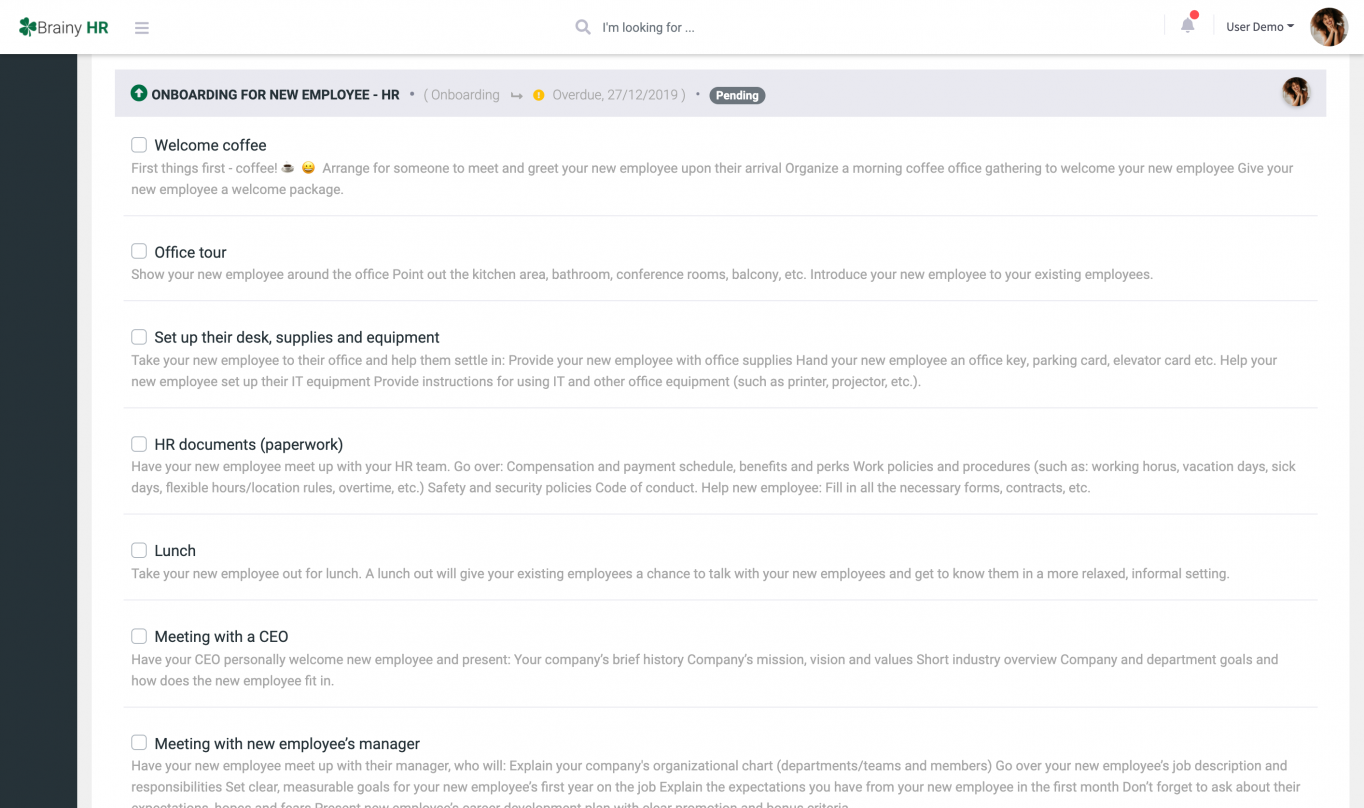Have you finally filled the vacant position, and the new employee’s first working day is approaching in great strides? Congratulations! Now is the time to start onboarding. Its class ultimately decides whether an employee stays with the company or starts looking for a new job.
“Welcome on board!” — Every new job should start with a warm welcome. If this is a structured and systematic process, it is “onboarding.” New employees should feel comfortable from the first day of work and quickly integrated into the company. The organization and the team because satisfied employees are more motivated, more committed, more productive. And they stay in operation longer — beyond the trial period.
No wonder that more and more attention to onboarding. According to statistics and best onboarding practices, almost 15 percent of all new employees think about resigning on their first day at work. In total, a third goes to the end of the trial period.
The first time onboard is not just a time to try out new things. The team also checks how the new employee fits. Both sides have great expectations of the start. The employee and the company make comparisons — the employee with previous training phases, the colleagues with other newcomers.
In times of a shortage of skilled workers, professional onboarding is becoming increasingly important. For employers, the induction of new employees and the associated integration process must work smoothly. Here we will show you which instruments help, which phases a successful onboarding goes through, best practices for onboarding new employees, and its advantages.
What Is Employee Onboarding?
Employee onboarding is a critical step in creating a positive employee experience, increasing the chance of an employee remaining with the company, and accelerating the achievement of full sub-productivity.
Employee onboarding aims to introduce a newly employed person to the daily duties and rules of the organization. It includes job/product training and all activities to help the employee acclimatize to the new environment. Depending on the organization, position, and complexity of duties, the onboarding process may last from several days to even several months.
The onboarding process is not just about getting on board for a while, but rather it covers the period from the contract’s signing to the end of the trial period.

Onboarding new employees, the best practices are usually divided into three phases:
-
preparation
-
orientation
-
integration
Onboarding goes far beyond getting to know each other or setting up the workplace. To guarantee a smooth onboarding process, companies are increasingly using software solutions and apps in digitization.
How Long Does Onboarding Take
How long the onboarding phase lasts depends on the company, the industry, and the complexity of the position. It can last for three months (or 100 days), the duration of the probationary period by onboarding best practices lasts up to a year.
The first working day is handy and has an impact on the other working days. Consequently, on its success — and the success of the company. From a company's point of view, establishing and cultivating good onboarding is nothing more than protecting the (recruiting) investments made previously and increasing profits. The real capital of the company is the people who work for it?
The aim should be that the new employee and colleague remain motivated, do not quit during the probationary period, and is part of the company for at least two, three, or more successful years.
Employee Onboarding Process: Step-By-Step Guide for Hrs
There are many variations on a crappy first day at work. There is no computer, no one informed about the new employee, busy manager, or lack of clear first objectives.
Recruiters and HR managers emphasize the importance of first impressions during the interview process. But many people forget to apply this rule to going to work (or inform managers about it). So, it is not a sign of lousy managers. It is the result of the lack of a transparent process in the company. Good strategy = good boarding.
We all know the statistics: 80% of those who quit in the first six months make this decision within the first two weeks of work. What is important and generally overlooked in most adaptation programs? Look at our step-by-step guide.
It is good to start onboarding before the employee appears in the company. Sending information about the first day of work and its class by e-mail reduces the anxiety and fear of the first day of work.
The employee can also receive a set of information about the company — access to the intranet. System with an onboarding program, or even a PDF document. It is essential that commitment to prepare employee onboarding guide usually it has three stages:
-
Before entering
-
First working day or first working week
-
Integration during the first three to six months
Before the first working day
Introduce colleagues to the newcomer before he/she crosses the threshold of the office on the first working day. Explain that everyone can help: order lunch, ask how things are, wish you a good evening, and ask if you need help. The difficulty behind this: onboarding begins before the first day at work!
Integration into the team as early as possible
If an employees contract is signed, the new colleague ideally starts his new job shortly afterward. Sometimes, however, weeks or even months pass before the start, for example, notice periods. Don't let this time go by unused. If there are company parties or team events, you should invite the new employee.
Communicate the date of entry in the company
A new colleague starts, and nobody knows about it, let your employees know as soon as possible of the entry date and make sure everyone is available to greet the newcomer. Onboarding planning tool appointments within the team are also useful. HR managers need to explain to the newcomer about the responsible area and what tasks they have.
Prepare the workplace
Clarify early enough which equipment the new employee will need to do their job. Do I have to order a laptop and a cell phone? And which office supplies are necessary? These things should be available to the newbie from day one.
Induction plan
Onboarding new employees best practices, concrete induction plans give structure to the integration of a new employee. In the best case, you can provide him with a mentor who accompanies him in his first few weeks and brings him closer to the corporate culture—record in writing which existing employees are involved in the induction and which tasks they take on. Go through the plan with the new employee to know what to expect in the coming days and weeks.
The first week of work
Everything is new, exciting, and maybe a little intimidating. Give the new colleague enough time to get used to it to acclimate. With a warm welcome from the team and a welcome gift as a small gift, you won't go wrong, and a lot of things are right.
The first week should be about bringing the newcomer closer to the company and familiarizing them with the customs. Take a tour of the company (or the mentor responsible) to introduce your new employee. You explain which departments are where and what happens there. The product range must also be gone through and illustrated so that the unknown is up to date.
Present the previously designed induction plan in a personal interview. You can then hand over the first tasks to the new employee. He is integrated into the daily workflow and can get a first impression of his area of activity. But don't overwhelm him.
Make sure you familiarize your new employee with the internal guidelines! Show how to take vacation or sick leave, how time recording works, or what things considered security.
Perhaps the most important in onboarding is communicating the corporate culture. How do employees treat each other, where are coffee and smoking breaks taken, and do they have lunch together or not? A new employee can quickly integrate into an existing team.
The integration
Usually, integration lasts from the third to the sixth month, but it can also take the entire first year of an employee. During this time, it is your job to integrate the newcomer into the company gradually and slowly but surely give him more and more personal responsibility.
9 Tips for Onboarding an Employee
More often, we work out the induction program from an HR function perspective. And in this case, we get a rather one-sided process. When entering an organization, a person faces the need to interact integrally with many areas and functions. He needs to get access to documents, coordinate business trips, interact on various finance department issues, etc. Many different problems need to solves at once.
If, in this situation, we perceive the newcomer to be provided with a great experience, just as we try for external clients, the result will be much higher. What do you need to do to expand your onboarding program in a way that creates a holistic and satisfying newbie experience? To optimize the onboarding of new colleagues, we present the essential tips and best practices for employee onboarding:
Create an induction plan for new employees
Rely on systematic onboarding. It is best to prepare everything before starting your job. In addition to the workplace, technology, and internal communication, you should develop an induction plan tailored to the new employee.
It includes introducing the team, the operational induction with all relevant processes, and the individually coordinated training. Determine milestones together with the new employee, provide feedback options through an employee survey, and take enough time to discover possible gaps.
First working day
Introduce the newcomer, assign a mentor to him, show him his workplace, and explain essential organizational things. Necessary: Explain the onboarding manual to him to quickly find the answers to his most important questions. Offer to come along for lunch! It is how he gets to know new colleagues directly.
First working week
In the first week, the new employee is shown around the building to get to know employees outside their department. He also familiarizes himself with the essential tools and areas of responsibility before really getting started.
As a supervisor, it is best to meet with him once a week for the first few weeks to receive direct feedback. The feedback discussion at the end of the first week is incredibly important.
Integrate your new employee on all three levels: professional, social and cultural
Incidentally, onboarding does not only take place at the technical level. The “newcomer” has to integrate professionally, with his know-how, socially, with his colleagues, and culturally, concerning the goals, principles, and philosophy.
It's hard to believe: Although the induction phase contributes to a high percentage that an employee stays with a company, only 14 percent of the HR departments provide an extra budget for onboarding. Existing employees are relieved if sufficient material and processes are available for training.
Arrange regular feedback and employee appraisals
Even if it has not fully arrived in many USA companies: Regular feedback through employee surveys is vital for the corporate culture! It's the main point of companies with the best onboarding practices, especially in the initial phase, when the new employee does not know the company well. Especially at the beginning, he needs to know whether his performance is going in the right direction.
Steps:
-
Prepare for the interview and observe the feedback rules!
-
Find possible sand in the transmission! Unaddressed conflicts block the whole team, - hinder social integration and reduce the overall result.
Automate your onboarding process
Start working with Brainy HR that can provide everything you need to make your employees happy!
Standardize and automate the onboarding process
The market researchers found that employee retention with standardized processes was, on average, 19 percentage points higher. Target achievement and employee performance were also better. If companies standardize every phase of the induction process, for example, with checklists and guidelines and defining responsibilities and deadlines in advance, they save time and resources. Customize standard onboarding programs for each new employee.
Use software and apps for your onboarding process.
-
While many HR departments today use software for many HR processes, most onboarding processes are not supported digitally. There are now numerous specialized employee onboarding solution with useful functions:
-
They help the HR department to manage the familiarization processes in the back end.
-
They guide new employees through the onboarding process on a branded user interface.
-
Ideally, they contain all the relevant information about joining the company.
-
New employees quickly get an overview of company standards and rules, dress code, essential processes, time recording, vacation planning, expense reports, parking.
-
Use e-learning modules to provide your employees with the necessary company or product knowledge.
-
Be careful not to flood your new hires with information. You can prioritize them and prepare them for him in bits and pieces.
Use a professional survey tool for your onboarding process.
In addition to software solutions and apps for the onboarding process, you can use a survey tool. You can integrate this into your applications and, for example, design an onboarding quiz that asks for relevant company or product information. Get your new employees on board quickly and easily!
You should avoid these mistakes.
Avoid anything that does not shed a good light on the company, appears unprofessional, and does not value your new employee.
Typical mistakes that are easy to avoid:
-
Your receptionist doesn't even know that a new employee is starting today.
-
Neither the HR department nor the manager welcomed the new employee.
-
The workplace has not yet been set up.
-
Colleagues don't care about the new guy.
-
It takes days before the employee can start.
It is enough that you only make one of the mistakes mentioned above, and you fail the new employee. Many then close down and are already looking for a job again in their heads.

Brainy HR’s Employee Onboarding Software
Digital onboarding has not just been a central HR topic since the Corona crisis. Digital employee onboarding best practices offers optimal support. Internal workflows that arise in the various departments during the onboarding process are automatically triggered and controlled — keyword HR digitization.
With a digital onboarding solution, useful information is made available to new employees that is understandable and tailored to the respective employee profile.
If you are in charge of HR in your company, your everyday life will dominate by such questions. The employee Onboarding data feels like a hundred different Excel tables or one of the ten folders. We have a few tips for you on how HR software can make your life easier and the onboarding best practices checklist process. In the next section, we have described in detail all the benefits of automation processes.
Benefits of a Brainy HR onboarding solution
1. Digital Pre-onboarding: Inspire the employee even before they start work
Here it is essential to provide various information about the company BEFORE starting work. The minimum is that the employee, e.g., receives a reminder email; better still, the data is bundled and structured online, e.g., with the help of an onboarding solution and via the app. Useful information, e.g., crucial provided for corporate culture, further training, external activities, etc. New employees can prepare for the new job individually and according to their schedule.
A digital onboarding solution and best practices for onboarding new employees not only inspires employees, but it is also an essential part of HR digitization and optimizes onboarding processes.

2. Brainy HR solution also offers the opportunity to network
Networking and exchanging with (future) colleagues is a crucial success factor for successful onboarding and HR digitization. An onboarding solution offers new employees — already in the pre-boarding phase — to get in touch with future work colleagues or other new employees. And of class, a digital tool also offers a direct line to the contact person in HR.
3. Support in the induction phase
So that everyone in the company knows who has to do what and when, it helps initiate the individual task packages in an onboarding solution and process them step by step as a workflow by different people/departments. Both administrative processes and specific induction plans for new employees are conceivable here.
Also, the employee onboarding software solution for your processes should be flexible and intuitive to use. Another critical point is the mapping of different roles in the company and customized views and differentiated input options.
Conclusion
Besides, it is essential to determine who should take part in the onboarding process. It is because this option is not limited only to newly hired employees. Such refreshment of knowledge can support parents returning from maternity leave, employees after a long absence, or people changing their place in the structure. These types of processes are also of great importance in the case of mergers and acquisitions.
Simultaneously, the key to designing adaptation measures is building the credibility and business justification of this type of program. Employees must see the tangible benefits of their involvement in onboarding. Therefore, process evaluation and regular business impact monitoring can provide essential information in onboarding design. It is worth starting with setting the program’s primary goals based on its needs and expectations, then looking at the available opportunities and creating a flexible framework for the process — its form, content, and duration.
The onboarding process reduces the risk that new hires will quickly submit their terminations. Properly conducted onboarding avoids misunderstandings, because the employee knows the company's expectations towards him well.
It is vital to plan the process well in terms of its content, people responsible for implementation, and available resources and duration. It is worth consulting with business representatives and conducting a survey among people starting work. The results can provide valuable information about the expectations and effectiveness of implementation activities carried out so far.


 Posted on Oct 8, 2020 by Anna
Posted on Oct 8, 2020 by Anna


